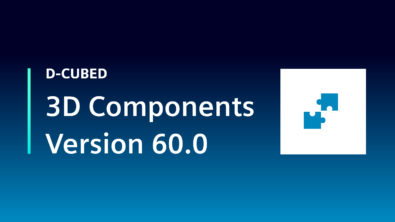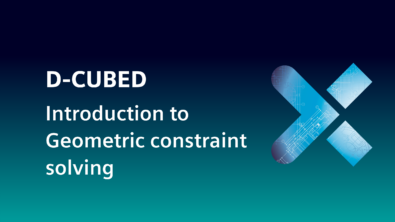PLM Components : an interview with CIMdata about Siemens’ open toolkits

Hundreds of software vendors choose PLM Components to develop applications in 3D modeling, simulation, visualization and collaboration. CIMdata, a leading strategic management consulting and research authority in PLM, recently researched the PLM Components business and reported their findings in a white paper.
We interviewed Ken Versprille, Executive Consultant at CIMdata, to discuss some of the key findings in CIMdata’s research and learn why open solutions like Parasolid and JT empower the next generation of 3D engineering software. Watch the interview to learn:
- Some of the main challenges facing software vendors when delivering new applications to the market
- How solutions like PLM Components help them to meet those challenges
- CIMdata’s assessment of the market penetration of PLM Components across various domains
- Why Siemens Digital Industries Software openly licenses PLM Components to potential competitors
Siemens PLM Components – Parasolid in particular and JT and
D-Cubed, really have a major, very major presence in the market
Ken Versprille, Executive Consultant, CIMdata
Additional resources
Full interview transcript
Margarita Pariente (Siemens)
Hello and welcome to our discussion with Ken Versprille at CIMdata who recently authored a white paper about Siemens PLM Components. I’m your host, Margarita Pariente and today I’ll be asking Ken how leading technologies like Parasolid and JT empower the next generation of 3D engineering software solutions.
Before we start, Ken could you introduce yourself to the audience and say a few words about your work with CIMdata?
Ken Versprille (CIMdata)
I’m probably most famous in the CAD world because my PhD dissertation was non uniform rational B splines which has been called now NURBs. And I’ve been with now with CIMdata almost 12 years doing basically the same kind of consulting where I work with both solution providers and industrial clients on their use of CAD.
Margarita Pariente
Thanks for joining us Ken we are very happy to have you with us. Let’s get started. I’d like to begin by asking what interested or surprised you most about PLM Components business when you were researching your white paper?
Ken Versprille
It was interesting to me to see where geometric kernels, specifically Parasolid, was being used. Your first glance is you would think in CAD modeling but it turns out that very often Parasolid was used in simulation – some of the simulation applications, some of the machining applications. JT – I sort of already knew… I had been looking at collaboration for the last 15/20 years and the different solutions to do collaboration and I knew JT was right up there and its use, specially in automotive.
Margarita Pariente
Can you talk about some of the challenges that software vendors face when developing new applications and how solutions like PLM Components help them to meet those challenges?
Ken Versprille
So time to market is very important. If they had to implement all the technology in their application that could take months, possibly even years, so components give them a head start. Over the years it’s become more and more apparent that industrial users want quality software. They can’t afford to deal with problems in the software to try to overcome them. They are expecting good quality. Is the component software provider innovating, or are they sitting there stagnant just trying to rest on their laurels of what they currently have? Are they adding to the product? The 4th area would be data interoperability… How difficult is it to get data into the component and get data out of the component so it can be shared with other applications, other tools that they’re using?
Margarita Pariente
So my next question is…As part of your research for the white paper, CIMdata assessed the market penetration of PLM Components in various PLM sectors. Could you elaborate on the results of that research?
Ken Versprille
CIMdata publishes every year what are called the marketing numbers: the sales from the different industrial solution providers. So we can see how much CAD is being sold. Where is it being sold and what country. How much simulation software is being sold, where – in what countries and what regions and what areas.
The problem is to look at component software… the solution providers do not publish those numbers. So what we chose to do was simply take a look at what were the market numbers of the products that contained a particular component software. And it turned out the results of that is by far the Siemens PLM Components, Parasolid in particular and JT and D-Cubed really have a major, very major presence in the market based on those kinds of numbers.
Margarita Pariente
Great to hear that! Your white paper includes a chapter about innovation in our industry, which is clearly important to software vendors who need to keep pace with industry trends. What were your findings about Siemens sharing its innovation through component technology with other software vendors?
Ken Versprille
I think that specifically what was being called out in the research was the work that had been done in Parasolid to deal with facet meshes and lattices. With the big push towards additive manufacturing that’s happening across the industry and in all all the different verticals, lattices provide a way of reducing weight, reducing use of materials, so that became very important, and what we saw coming out of Parasolid, keeping pace with that level of technology, was very important to end users.The other area was in Kineo, the component to handle robotic simulation and robotic controls. That was very, very well appreciated by a lot of the end-users.
Margarita Pariente
I often get asked why Siemens openly licenses PLM Components to potential competitors when it could keep the technology in-house and create some competitive advantage… What kind of benefits do you see for a software vendor like Siemens choosing to be open?
Ken Versprille
Well, when it comes down to it, I think any reasonable person in this industry will agree it is a heterogeneous world. No one vendor can provide everything or keep up with the trends everywhere. You need to play in a multi solution provider environment. By keeping, as Siemens does, an open environment on their own tools, they play perfectly into that kind of mindset. That kind of technology positioning. And it’s well appreciated by other end users, by the other vendors who want to complement some of the Siemens tools.
Margarita Pariente
Well, thanks again Ken for joining us today and sharing your insights into the PLM Components business.
Ken Versprille
Thank you for the opportunity to speak with you and your users.


